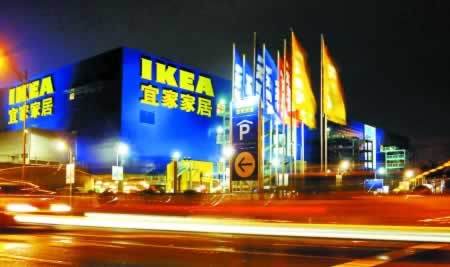我们都爱逛宜家:宜家开首家韩国分店(双语)
 宜家
宜家It took some time to figure out just the right shopping complex, off just the right highway interchange and just the right distance from Seoul, that could accommodate a 624,000-square-foot store—that is to say, one more than three times the size of the average Wal-Mart Supercenter. It took more time to solve certain mysteries, like how big to make the store’s children’s section in a country where kids are often given ample space in the family living quarters. It took more time to figure out how to showcase kitchens that incorporate kimchi refrigerators, a uniquely Korean appliance—and even more time to untangle nuances of the market, like the South Korean’s preference for metal chopsticks.
要规划出一个恰到好处的购物中 心,正好位于某个合适的高速公路出口旁,与首尔的车程还不远不近,面积高达62万4千英尺(比一个标准沃尔玛超市的面积大三倍多),是需要花点时间的。而
要解决某些特定难题,比如,在韩国这样一个孩子在家中享有充足活动空间的国家,购物中心的儿童区该做多大才合理,需要花更多功夫。至于如何布置一个能容纳 韩式泡菜冰箱这种韩国特有家电的厨房,就要花上更多时间——而要弄清这个市场的微妙之处,比如韩国人对金属筷子的偏爱,则又要搭上更多时间。
In all, it took about six years for Ikea to unveil its inaugural store in South Korea, in Gwangmyeong, starting from the first scouting trip. Ikea celebrated the opening in December with a tree planting rather than ribbon cutting. (Chalk that up to Ikea tradition rather than to South Korean custom。)
总而言之,从宜家公司首次考察韩国市场,到在光明市开设第一家韩国分店,花了约整整六年时间。去年12月,宜家用植树而非剪彩来庆祝这家店开业(沿用了宜家传统,而不是韩国习俗)。
The lag was quintessentially Ikean. “They are ferocious about not expanding too rapidly,” says David Marcotte of consulting firm Kantar Retail. But six years? “The more global, the more complex it gets,” replies Mikael Palmquist, the regional manager of retail for Asia Pacific. “We need to get these things right or we will never be taken seriously。”
这种缓慢是典型的宜家风格。 零售咨询公司Kantar Retail的戴维·马科特说:“扩张太快会让他们抓狂的。”但至于要花六年吗?宜家亚太区区域零售经理米卡埃尔·帕姆奎斯特表示:“公司越是全球化,业 务扩张就越复杂。我们必须行事谨慎,否则客户就永远不会重视我们。”
Even with all that careful planning, Ikea managed to get a few things wrong. It misjudged the number of parking spaces needed, and a seemingly benign map for sale upset some customers: The body of water east of Korea was labeled the Sea of Japan rather than the East Sea, as South Koreans prefer。
即便规划如此周详,宜家还是办错了好几桩事。它错估了实际所需的停车位数量,还有一张看似友好的地图却让不少客户很不舒服:朝鲜东部的海被标注为日本海,而不是韩国人所习称的东海。
But the Koreans seem, for the most part, to have forgiven the Swedes. Today the Gwangmyeong store, which is the company’s largest in the world by shopping area, is on track to become one of Ikea’s top-performing outlets for 2015.
但韩国人看起来大体上已经原谅了这家瑞典巨头。光明市分店是宜家在全球购物区域面积最大的一家店,现在人气很旺,有望成为宜家2015年业绩最佳的分店。
The success is hardly a fluke. Ikea, it seems, is a genius at selling Ikea—flat packing, transporting, and reassembling its quirky Swedish styling all across the planet. The furniture and furnishings brand is in more countries than Wal-Mart, Carrefour, and Toys “R” Us. China, where Ikea has eight of its 10 biggest stores, is the company’s fastest-growing market. An outlet in Morocco is coming soon, and there are hints that Brazil may not be far off. Meanwhile, Ikea is going meatballs out in India, where it plans to invest about $2 billion over a decade to open 10 stores。
这份成功来得绝非侥幸。宜家似乎是一个营销天才——扁平式包装,方便拼装,那些带有瑞典风情的家具正在销往全世界。和沃尔玛、家乐福及玩具反斗城相比,这个瑞典家具品牌已打入了更多国 家的市场。宜家十大分店中有8家在中国,中国也是该公司增长最快的市场。摩洛哥分店即将开张,还有传闻说巴西分店也开张在即。同时,宜家打算将其瑞典肉丸 卖到印度更多地方,在未来十年投资20亿美元,在印度开设十家分店。
Getting it right in emerging markets like China and India, where Ikea is well-positioned to capitalize on a growing middle class, is a key factor in its goal of hitting 50 billion Euro in sales by 2020. That’s up from 28.7 billion Euro in its fiscal 2014 ($39 billion based on the average exchange rate for Ikea’s fiscal year) and almost double its 2005 sales level. Today the Ikea Group has 318 stores, not including the brand’s some four dozen franchised locations; it’s aiming for around 500 by 2020.
抓稳新兴市场,是宜家实现 2020年销售突破500亿欧元目标的关键因素。在中国和印度,宜家已做好市场定位,瞅准当地迅速崛起的中产阶级。这是个雄心勃勃的目标:2014财年,
宜家的销售额为287亿欧元,几乎比2005年的销售额翻了一番。目前宜家集团拥有318家分店,这还不包括48家特许加盟店;到2020年,宜家的另一 个目标是:开店数量达到500家。

